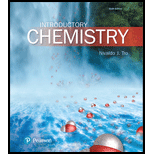
Concept explainers
Determine the molecular geometry of each polyatomic ion.
a.
b.
c.
d.
Learn your wayIncludes step-by-step video

Chapter 10 Solutions
Introductory Chemistry (6th Edition)
Additional Science Textbook Solutions
Essential Organic Chemistry (3rd Edition)
Chemistry & Chemical Reactivity
Chemistry: A Molecular Approach (4th Edition)
Chemistry: A Molecular Approach
Organic Chemistry
General Chemistry: Atoms First
- Which of the following species has trigonal-pyramidal geometry? (a) PCl3 (b) BCl3 (c) SO3 (d) ClF3arrow_forwardIdentify the molecules with a dipole moment: (a) SF4 (b) CF4 (c) Cl2CCBr2 (d) CH3Cl (e) H2COarrow_forwardPredict the molecular structure and bond angles for each molecule or ion in Exercises 87 and 93. a. CCl4 b. NCl3 c. SeCl2 d. ICl a. NO2, NO3, N2O4 (N2O4 exists as O2NNO2.) b. OCN, SCN, N3 (Carbon is the central atom in OCN and SCN.)arrow_forward
- A molecule XF6 (having no lone pairs) has a dipole moment of zero. (X denotes an unidentified element.) When two atoms of fluorine have been taken away, you get the molecule XF4, which has dipole moment of 0.632 D. XF6XF4+2F Describe the molecular geometry for each molecule. What are some possibilities for X?arrow_forwardUse Lewis structures and VSEPR theory to predict the electron-region and molecular geometries of (a) PSCl3. (b) SOF6. (c) [S2O4]2. (d) [TeF4]2. Note any differences between these geometries.arrow_forwardPredict the molecular structure (including bond angles) for each of the following. (See Exercises 115 and 116.) a. ICl5 b. XeCl4 c. SeCl6arrow_forward
- Predict the molecular structure (including bond angles) for each of the following. (See Exercises 115 and 116.) a. XeCl2 b. ICl3 c. TeF4 d. PCl5arrow_forwardAmong the following, which has the shortest bond and which has the longest: Li2, B2, C2, N2, O2?arrow_forwardAs a general rule, MX molecules (where M represents a central atom and X represents terminal atoms; n = 2 5) are polar if there is one or more lone pairs of electrons on M. NH3 (M = N, X = H, n = 3) is an example. There are two molecular structures with lone pairs that are exceptions to this rule. What are they?arrow_forward
- For each of the following molecules, state the bond angle (or bond angles, as appropriate) that you would expect to see on the central atom based on the simple VSEPR model. Would you expect the actual bond angles to be greater or less than this? a CCl4 b SCl2 c COCl2 d AsH3arrow_forwardWhich of these molecules have an odd number of valence electrons: NO2, SCl2, NH3, NO3?arrow_forward
 Chemistry by OpenStax (2015-05-04)ChemistryISBN:9781938168390Author:Klaus Theopold, Richard H Langley, Paul Flowers, William R. Robinson, Mark BlaserPublisher:OpenStax
Chemistry by OpenStax (2015-05-04)ChemistryISBN:9781938168390Author:Klaus Theopold, Richard H Langley, Paul Flowers, William R. Robinson, Mark BlaserPublisher:OpenStax ChemistryChemistryISBN:9781305957404Author:Steven S. Zumdahl, Susan A. Zumdahl, Donald J. DeCostePublisher:Cengage Learning
ChemistryChemistryISBN:9781305957404Author:Steven S. Zumdahl, Susan A. Zumdahl, Donald J. DeCostePublisher:Cengage Learning
 Chemistry & Chemical ReactivityChemistryISBN:9781133949640Author:John C. Kotz, Paul M. Treichel, John Townsend, David TreichelPublisher:Cengage Learning
Chemistry & Chemical ReactivityChemistryISBN:9781133949640Author:John C. Kotz, Paul M. Treichel, John Townsend, David TreichelPublisher:Cengage Learning Chemistry & Chemical ReactivityChemistryISBN:9781337399074Author:John C. Kotz, Paul M. Treichel, John Townsend, David TreichelPublisher:Cengage Learning
Chemistry & Chemical ReactivityChemistryISBN:9781337399074Author:John C. Kotz, Paul M. Treichel, John Townsend, David TreichelPublisher:Cengage Learning Chemistry: The Molecular ScienceChemistryISBN:9781285199047Author:John W. Moore, Conrad L. StanitskiPublisher:Cengage Learning
Chemistry: The Molecular ScienceChemistryISBN:9781285199047Author:John W. Moore, Conrad L. StanitskiPublisher:Cengage Learning





